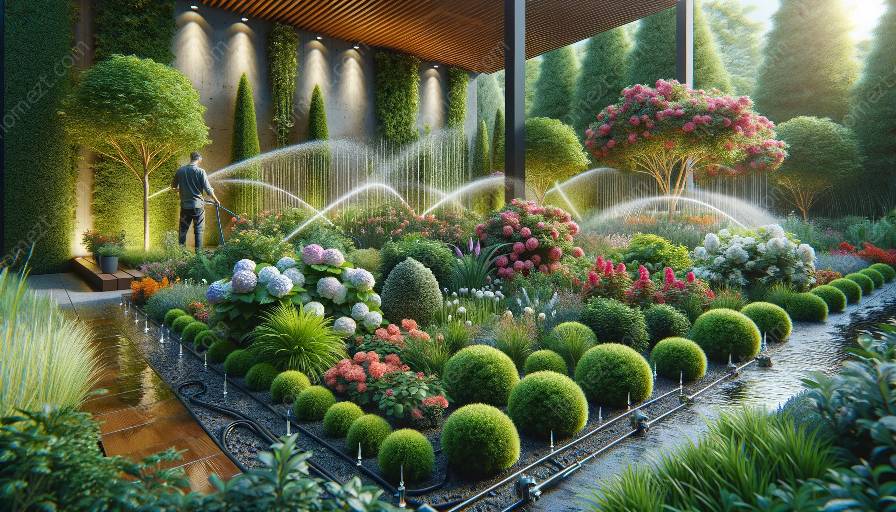Shrubs and bushes play a vital role in garden landscaping, adding beauty and structure to outdoor spaces. To ensure their healthy growth and vibrant appearance, it is essential to understand the various watering and irrigation techniques that are most suitable for these plants. In this comprehensive guide, we will explore everything you need to know about watering and irrigation for shrubs and bushes, including the importance of proper watering, best practices for irrigation, and effective techniques to maintain a thriving garden.
The Importance of Proper Watering
Watering is a fundamental aspect of plant care, and shrubs and bushes are no exception. These plants require consistent moisture to promote healthy root development and overall growth. Without adequate water, shrubs and bushes may become stressed, leading to wilting, leaf drop, and decreased resilience to pests and diseases. Understanding the specific water needs of different shrub and bush species is crucial for maintaining an optimal growing environment.
Factors Influencing Watering Needs
Several factors can influence the watering requirements of shrubs and bushes, including their species, location, soil type, and climate. For example, shrubs planted in sandy soil may need more frequent watering than those in loamy soil due to differences in water retention. Similarly, shrubs and bushes in hot, arid climates will typically require more water compared to those in cooler, moister regions.
It is important to assess these factors when planning a watering schedule to ensure that the needs of each plant are met. Observing the condition of the plants, soil moisture levels, and weather patterns can help determine the appropriate frequency and amount of water required for optimal growth.
Best Practices for Irrigation
Effective irrigation is essential for delivering water to shrubs and bushes in a controlled and efficient manner. Implementing proper irrigation techniques can help conserve water, minimize runoff, and promote deep root growth. Here are some best practices for irrigation in garden settings:
- Drip Irrigation: Drip irrigation systems deliver water directly to the root zones of plants, reducing water loss through evaporation and runoff. This method provides a slow, steady supply of water, promoting deep root penetration and minimizing surface moisture, which can attract pests and fungal diseases.
- Soaker Hoses: Soaker hoses are porous hoses that release water along their length, allowing for gradual and uniform watering. These hoses can be laid out around shrubs and bushes, delivering water directly to the soil while minimizing water wastage and runoff.
- Mulching: Applying a layer of organic mulch around shrubs and bushes can help conserve soil moisture by reducing evaporation and regulating soil temperature. Mulch also helps suppress weeds, improving the overall health and appearance of garden beds.
- Timing: Watering early in the morning is generally recommended, as it allows plants to take up moisture before the sun evaporates it. Avoiding midday watering can help prevent rapid evaporation and minimize the risk of fungal diseases.
Effective Techniques for Maintaining a Thriving Garden
In addition to proper watering and irrigation, there are several techniques that can contribute to the overall health and vitality of shrubs and bushes in a garden setting:
- Grouping Plants: Grouping shrubs and bushes with similar water requirements together can simplify irrigation and ensure that each plant receives the appropriate amount of water.
- Monitoring Soil Moisture: Regularly checking soil moisture levels using a moisture meter or by manually assessing the soil can help determine when watering is necessary. This practice can prevent both under- and over-watering, promoting balanced plant growth.
- Adjusting for Seasonal Changes: Recognizing the impact of seasonal variations on water requirements is crucial. During periods of drought or intense heat, it may be necessary to adjust watering frequency and duration to accommodate the plants' needs.
- Implementing Rainwater Harvesting: Collecting and utilizing rainwater for irrigation purposes can be an eco-friendly and cost-effective approach to watering shrubs and bushes, reducing reliance on municipal water sources and conserving water resources.
Conclusion
Watering and irrigation techniques are fundamental components of maintaining a healthy and vibrant garden, particularly when it comes to nurturing shrubs and bushes. By understanding the specific water needs of these plants and implementing effective watering practices, gardeners can ensure optimal growth and long-term sustainability. With the knowledge gained from this guide, you can confidently incorporate proper watering and irrigation techniques into your gardening routine, contributing to the overall beauty and vitality of your outdoor landscape.




















